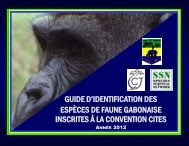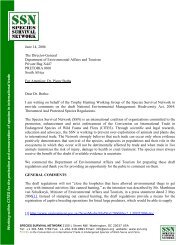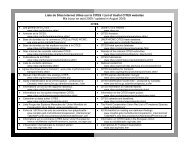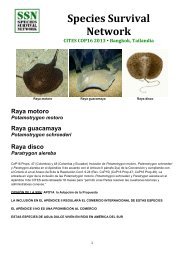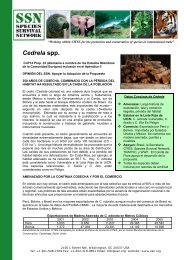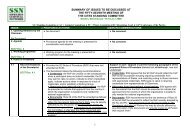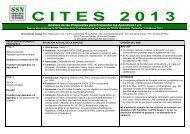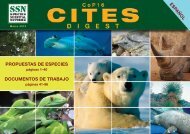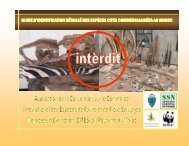CITES CoP16 Digest - Species Survival Network
CITES CoP16 Digest - Species Survival Network
CITES CoP16 Digest - Species Survival Network
Create successful ePaper yourself
Turn your PDF publications into a flip-book with our unique Google optimized e-Paper software.
SPECIES/PROPONENT/PROPOSAL CURRENT STATUS OF SPECIES SSN VIEW<br />
Prop. 57<br />
Laguna beach live-forever and Santa<br />
Barbara Island live-forever<br />
Dudleya stolonifera and Dudleya traskiae<br />
• Distribution: USA; D. stolonifera:six occurrences in an area approximately<br />
10 km2; D. traskiae:Santa Barbara Island, 2.6 km2.<br />
• Population: Both Endangered (Walter and Gillett 1998); D. stolonifera: approximately<br />
30,000 individuals; D. traskiae: approximately 1,000 individuals.<br />
• Threats: D. stolonifera: urban development and invasive non-native plants;<br />
D. traskiae: activity from nesting California brown pelican (Pelecanus occidentalis<br />
californicus), herbivory, and soil erosion.<br />
• Trade: Only one export reported for 2,461 artificially propagated specimens<br />
from France in 1985; protected under USA federal law.<br />
SUPPORT<br />
USA<br />
Delete from Appendix II<br />
Prop. 58<br />
Malagasy ebony<br />
Diospyros spp.<br />
Madagascar<br />
Inclusion in Appendix II, populations of Madagascar,<br />
limited to logs, sawn wood and veneer<br />
sheets by annotation<br />
• Distribution: Madagascar; widely distributed.<br />
• Population: Proposal pertains to 83 endemic species (all species in official<br />
Madagascar list of Diospyros except for non-endemic Diospyros ferrea); only<br />
13 Malagasy Diospyros spp. assessed by IUCN (3 listed as Endangered, 8<br />
Vulnerable, 1 Near Threatened and 1 Lowest Concern (PC19 Doc. 14.3)); field<br />
observations indicate declines of commercially exploitable (i.e. large) specimens<br />
and population declines.<br />
• Threats: Over-collection for international trade leading to localized extinctions<br />
(e.g. disappearance of Diospyros perrieri from western Madagascar);<br />
high and increasing levels of illegal trade; degradation, fragmentation and<br />
reduction of habitat over entire range due to slash and burn agriculture,<br />
bushfires, woodcutting, expansion of crops and agriculture.<br />
• Trade: Wood highly sought in international trade due to its luster, density<br />
and resistance to heat and cold; very high prices in trade (US$100 per board<br />
foot or higher); Madagascar ebony considered to be blackest of Diospyros<br />
species, more coveted than other African ebonies (Woodshopnews, 2010);<br />
more than 90% of exported products are logs and sawn wood, which are targeted<br />
by the proposed listing, but reduction in number of large trees has led<br />
to exploitation of younger trees and smaller species (e.g., D. squamosa and<br />
D. aculeata) for manufacture of artisanal objects (such as musical instruments)<br />
indicating potential shift in trade.<br />
SUPPORT<br />
• <strong>Species</strong> of Diospyros listed as Endangered in the IUCN Red List impossible<br />
to distinguish from other Diospyros species in trade, justifying listing of<br />
entire genus.<br />
• <strong>Species</strong> vulnerable due to low regeneration rates and slow growth rates<br />
(at least 80 years to reach commercially exploited size).<br />
• Some species (D. baroniana, D. filipes, D. implexicalyx, D. nidiformis, D. perglauca,<br />
D. subfalciformis, D. tampinensis, D. tetraceros and D.thouarsii) only<br />
grow outside protected areas, increasing likelihood of over-exploitation.<br />
• High demand in international trade; high market value.<br />
• Well-documented and increasing illegal trade serves markets in China,<br />
USA and Europe (EIA 2010).<br />
• Appendix II will allow Madagascar to strengthen implementation of its<br />
national laws and to seek the assistance of other <strong>CITES</strong> Parties (particularly<br />
consumer countries) to stop illegal trade.<br />
• Meets criteria for Appendix II (RC 9.24 (Rev. CoP15), Annex 2a)<br />
and Annex 2b)): internationally traded • declining wild populations<br />
• poor management due to lack of regulations • high<br />
global demand • some species Endangered • listing of the<br />
entire genus justified because of look-alike concerns<br />
www.ssn.org<br />
31



